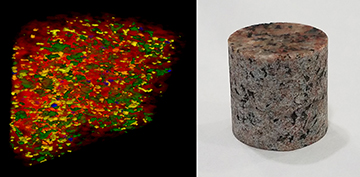
The neutron interferometer can scan the interior of thick objects, such as this chunk of granite, to provide enough detail to show the four types of rock that are mixed within it. [Image: Huber and Hanacek / NIST]
Moiré patterns—interference patterns generated by overlapping sets of parallel lines—can be annoying to graphic designers and television viewers. When deliberately created with silicon phase gratings, though, the moiré effect creates a new kind of neutron interferometer that could probe the insides of opaque objects in great detail (Phys. Rev. Lett., doi:10.1103/PhysRevLett.120.113201).
Scientists based at several U.S. and Canadian laboratories used a three phase-grating setup and an intense neutron beam to scan nondestructively the innards of solid objects to resolve details from 1 nm to 10 μm. The technique could be applied to everything from materials science to fundamental studies of gravity.
Toward a less finicky system
The gold standard in neutron interferometry has been the perfect-crystal technique, in which scientists align three silicon slabs to diffract the neutron beam. However, the method has several drawbacks—not only does it require positional precision down to a few angstroms, but it is also highly sensitive to environmental disruption. Only two laboratories own working, calibrated perfect-crystal neutron interferometers.
One of those institutions, the U.S. National Institute of Standards and Technology (NIST), collaborated with University of Waterloo physicists to design the moiré device. Researchers could focus the three transparent silicon gratings, each with a period of 2.4 μm, by moving them only a fraction of a millimeter, and the far-field interference patterns were orders of magnitude larger than the period of the gratings, which made them easy to image and study. The gratings also allowed almost all the neutrons in a beam from NIST's 20-MW reactor to pass through the experimental setup, compared to the small fraction of neutrons that manage to travel through the perfect silicon crystals.
From meteorites to gravity
In addition to the obvious applications of the technique—from probing the interiors of meteorites to analyzing porous minerals for their oil and gas content—the authors suggest that the phase-grating moiré interferometer could help measure both the local acceleration of gravity, g, and the Newtonian gravitational constant, G. Other scientists had used a neutron interferometer to measure g in 1975, but the new, higher-sensitivity technique might resolve the discrepancies in more recent measurements of G.
Researchers from the U.S. National Institutes of Health, the University of Arizona (USA) and North Carolina State University (USA) were also involved in the work.
